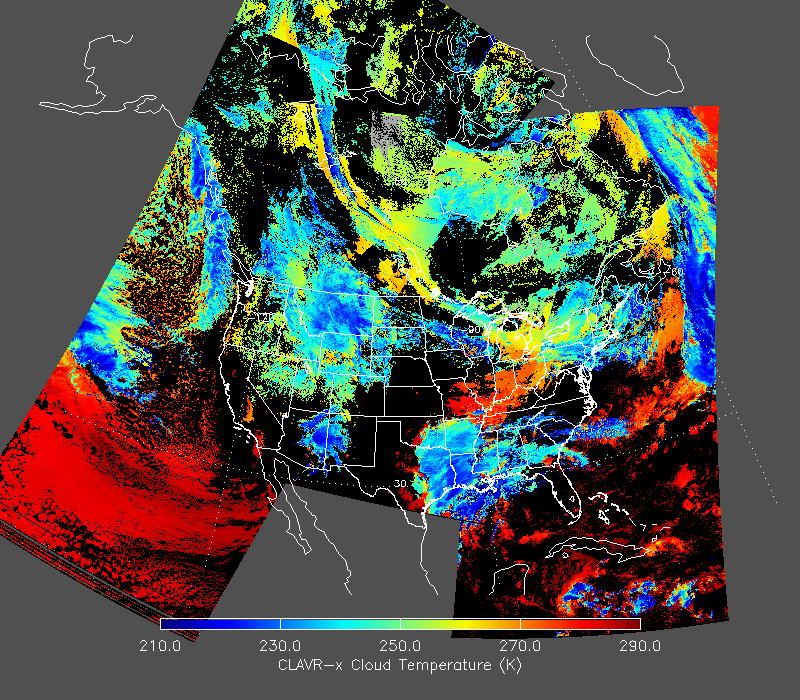
[ Archive ]

 |
CIMSS-NOAA Weekly Report
[ Archive ] |
 |
IN THE PRESS:
ITEMS FOR THE ADMINISTRATOR:
ITEMS FOR THE ASSISTANT ADMINISTRATOR:
Operational Use of Polar Winds Data by the National Centers for Environmental Prediction: The NOAA National Centers for Environmental Prediction (NCEP) began using the Moderate
Resolution Imaging Spectroradiometer (MODIS) polar winds product in
the Global Forecast System (GFS) on November 29, 2005. Six other
numerical weather prediction centers currently use the MODIS winds in
operational forecast system: the European Centre for Medium-Range
Forecasts (ECMWF), the NASA Global Modeling and Assimilation Office
(GMAO), the Japan Meteorological Agency (JMA), the Canadian
Meteorological Centre (CMC), the Fleet Numerical Meteorology and
Oceanography Center (FNMOC) of the Naval Research Lab, and the UK Met Office. The winds are
generated in NESDIS operations (OSDPD) and produced experimentally in real-time at the University of Wisconsin
Cooperative Institute for Meteorological Satellite Studies
(CIMSS). (J. Jung, CIMSS, 301-763-8204, T. Zapotocny, CIMSS,
608-262-0800, J.
Key, E/RA2, 608-263-2605, D. Santek, CIMSS, 608-263-7410, C. Velden,
CIMSS, 608-262-9168, J. Daniels, E/RA2, K. Turner, OSDPD)
Significance:
At least eight numerical weather prediction centers have demonstrated
that the MODIS polar winds have a positive impact on weather forecasts
not only within the polar regions, but also in the
extratropics. The operational use of the wind data by NCEP further demonstrates the utility of the product.
NOAA Mission Goal:
Serve society's needs for weather and water information.
NOAA Cross-Cutting Priorities:
Sound, Reliable State-of-the-Art Research
ITEMS FOR THE OFFICE DIRECTOR, STAR:
Cooperative Institute for Climate Studies Science Review: Prof. Steve Ackerman, Director of CIMSS chaired the Cooperative Institute for Climate Studies (CICS) 5-year science review panel. Other panel members included Reza Khanbilvardi, Wayne Higgins and Soroosh Sorooshian. A report will be forthcoming. (S. Ackerman, CIMSS, 608-263-3647)
Direct Broadcast Data from SSEC processed through CLAVR-x: High resolution data (1 km) from NOAA's Advanced Very High Resolution Radiometer (AVHRR) received from the Space Science and Engineering Center (SSEC) at the University of Wisconsin were processed through the Clouds from AVHRR extended (CLAVR-x) cloud processing system. CLAVR-x will be the operational cloud detection and cloud processing system for the upcoming European polar orbiting system (METOP) which will provide global data at 1 km from the AVHRR for the first time. The high resolution data from direct broadcast is being used to verify the 1 km performance of CLAVR-x before the launch of METOP. (A. Heidinger, E/RA2, 608-263-6757; W. Straka, UW/CIMSS, 608-262-5128)
 (Click image to enlarge)
(Click image to enlarge)
Release of 3D Wavelet-RVLC Data Compression Software for GOES-R HES: The 3D Wavelet-Reversible Variable-Length Coding (3D Wavelet-RVLC) software version 1.0 is released for lossless compression of ultraspectral sounder data in support of the NOAA Geostationary Operational Environmental Satellite-R (GOES-R) Hyperspectral Environmental Suite (HES) data compression project. NOAA co-leads are Roger Heymann of OSD and Timothy Schimt of ORA. The software, developed at the Cooperative Institute for Meteorological Satellite Studies (CIMSS) can be obtained at http://cimss.ssec.wisc.edu/compression/software. (B. Huang, CIMSS, 608-265-2231, bormin@ssec.wisc.edu)
ITEMS FOR THE DIVISION CHIEF, CoRP